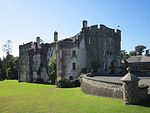Wiston Castle

Wiston Castle (Welsh: Castell Cas-wis) is a motte and bailey castle in the Pembrokeshire village of Wiston in south west Wales and is one of the best examples of its type in Wales. The castle and village were founded by Wizo, a Flemish settler who was granted the land by Henry I of England after he had wrested control from the previous owner, Arnulf de Montgomery (who was in revolt against Henry). The castle was captured by the Welsh on several occasions but on each occasion it was retaken. It was abandoned during the thirteenth century when the then owner moved to nearby Picton Castle. The castle is situated opposite St Mary Magdalene Church and there are approximately 50 steps leading up to it. It is in the care of Cadw and is a Grade I listed building and a Scheduled Monument.
Excerpt from the Wikipedia article Wiston Castle (License: CC BY-SA 3.0, Authors, Images).Wiston Castle
Conkland Hill,
Geographical coordinates (GPS) Address Nearby Places Show on map
Geographical coordinates (GPS)
| Latitude | Longitude |
|---|---|
| N 51.82641 ° | E -4.87177 ° |
Address
Wiston Castle
Conkland Hill
SA62 4PL
Wales, United Kingdom
Open on Google Maps








